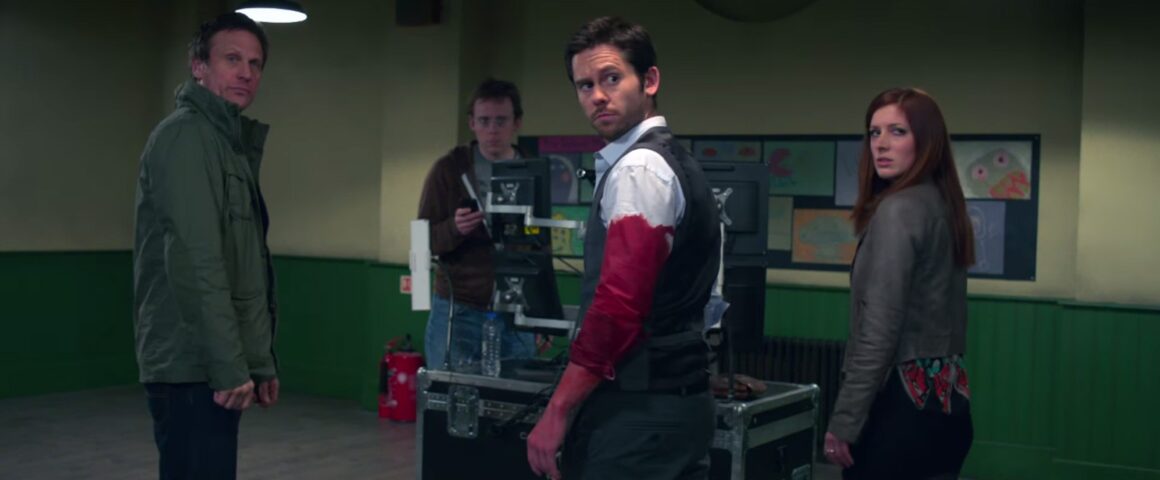Judas Ghost, an indie British horror/fantasy inspired by Simon R. Green’s “Ghost Finders” series, feels more like a sequel than a standalone piece. This is to say, while watching it, one feels like what they are seeing would make far more sense — and have far higher stakes — if significantly more background information had been provided for them regarding its characters, plot, and universe. The glaring lack thereof causes a novel, intriguing premise to completely sputter out by its disappointing end, which made me, as someone who started out really wanting to like this film, feel utterly let down.
The entirety of Judas Ghost (aside from scant clips and flashbacks, which muddy the viewer’s conception of point of view more than they actually advance the plot) takes place in one room in a building alternately referred to as a hall and school for both young children and teenage piano students. A team of Ghost Hunters (or Finders, I suppose) have been sent by the Carnacki Institute to create a training video of a routine haunting to educate young hopefuls in their field. This conceit, as well as how quickly and organically exposition is delivered in the first few minutes of the film, are far and away its strongest aspects. Unfortunately, they both disappear far too soon.
See, the film takes place in a world where the Carnacki Institute is an established agency, ghost hunting is a profession that involves recognized and legitimate training and results, and some of the hunters employed have actual psychic abilities. The team making the training video includes one such psychic, Anna (Lucy Cudden, “Pulp”), who has some sort of sexual tension with the quintessential overly cocky group leader, Jerry (Martin Delaney, “Zero Dark Thirty”); resident tech geek Ian (Alexander Perkins, “Pride”), and shady, previously institutionalized veteran Mark (Simon Merrells, “The Wolfman”). The first things these archetypical characters call to mind are formulaic true-crime procedurals, and it was exciting at the start of the movie to anticipate a scary story that would read like a workplace drama in an unfamiliar yet well established universe that took advantage of its training video premise to experiment with some found footage tropes as well.
Unfortunately, no such genre subversion exists in the actual film. While the filming of the training video is utilized in the very beginning to illustrate how much Jerry thinks he is above making the video and the types of ghosts one could potentially encounter on such a mission (namely: poltergeists, spirits to be exorcised, revenants, and, worst of all, beasts), its creation as narrative technique is abandoned long before the camera itself literally explodes in Mark’s hands.
Anna, presumably the most qualified of any of the team due her “psychicness,” literally does not do anything (like read minds, search for ghosts, or put up psychic shields to protect the team, for example) without first having been told to by Jerry. Whatever strained romantic history is supposed to exist between them is also never explained, even though, at one point, Jerry apologizes for it. Even more frustrating, it makes absolutely no sense that the skittish, squeamish, easily frightened and manipulated Ian would have ended up in this profession in the first place, despite the fact that an exchange between him and Jerry at the very beginning of the film implies that he’s been doing this kind of work for a long time. Anna even asks why he started doing this at one point, though the question both remains unanswered and is presented as a joke in response to him wailing that he is afraid of the dark.
The least explained character of them all is Mark, the expert who had led a team like Jerry’s for more than fifteen years before they all died on a job in a place called Buchanan Abbey and he was sent to an asylum to recover from whatever transpired there. Despite Jerry frequently asking him to, Mark never fully explains what happened. This is made even more confusing when Mark says that he thinks he’s contended with the overwhelmingly powerful spiritual force that has come to attack the team in Judas Ghost in the past, at the Abbey, leading one to think the more information he shares with the rest of the team about it, the more likely they all are to survive.
In regards to narrative technique, though, this movie’s biggest sin is its introduction of plot points and universe rules only as they become relevant, and not a moment sooner, making what would otherwise be seen as understandable developments and solutions nothing more than random deus ex machina.
All of that having been said, the practical effects are impressive, the voice modulation on the revenant who joins them is cool, and the choice to have the whole movie take place in one room totally worked (and, I’m sure, saved tons of money). The pacing of the majority of the movie works as well, but then it feels like it wraps up too quickly, and the definition of the “judas goat,” or the animal that leads others into the slaughterhouse, is not clearly applied (even though the title of the film is obviously a play on this phrase) at all.
So, while it started out unique and fun, the poorly defined characters/rules/universe, rushed ending, and far too easy solution to the haunting honestly left me wishing that Judas Ghost had just been a found footage version of a training film gone awry instead, which is something I never thought I would say.




'Movie Review: Judas Ghost (2013)' has no comments